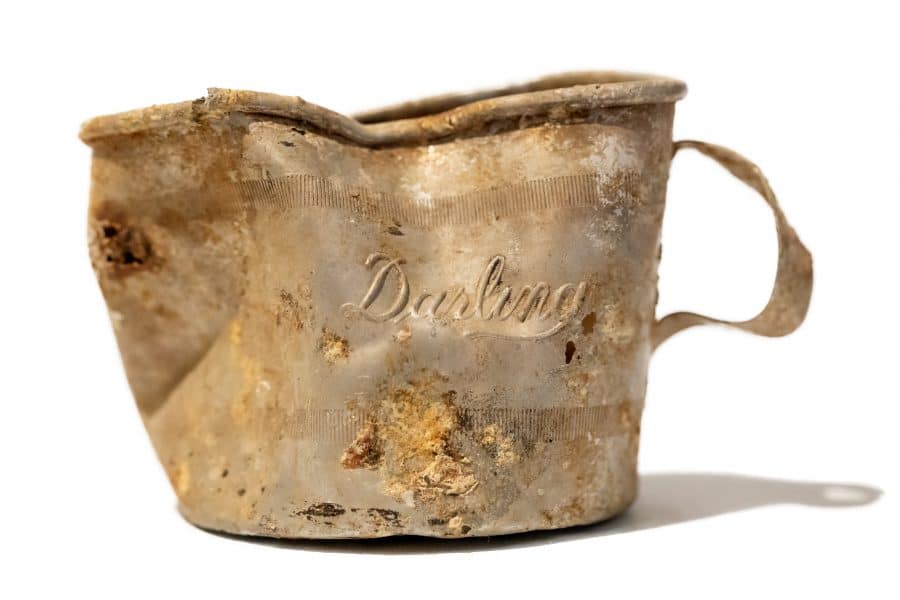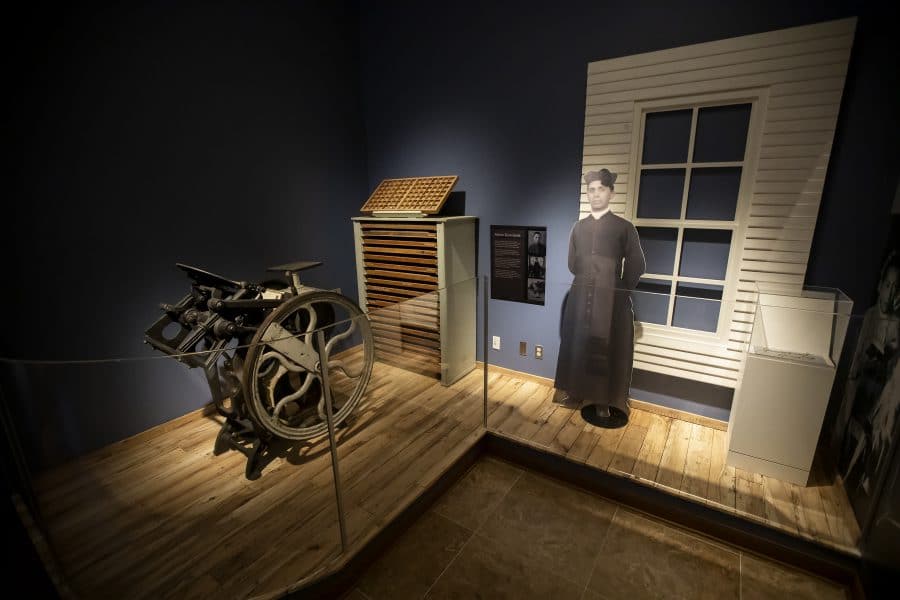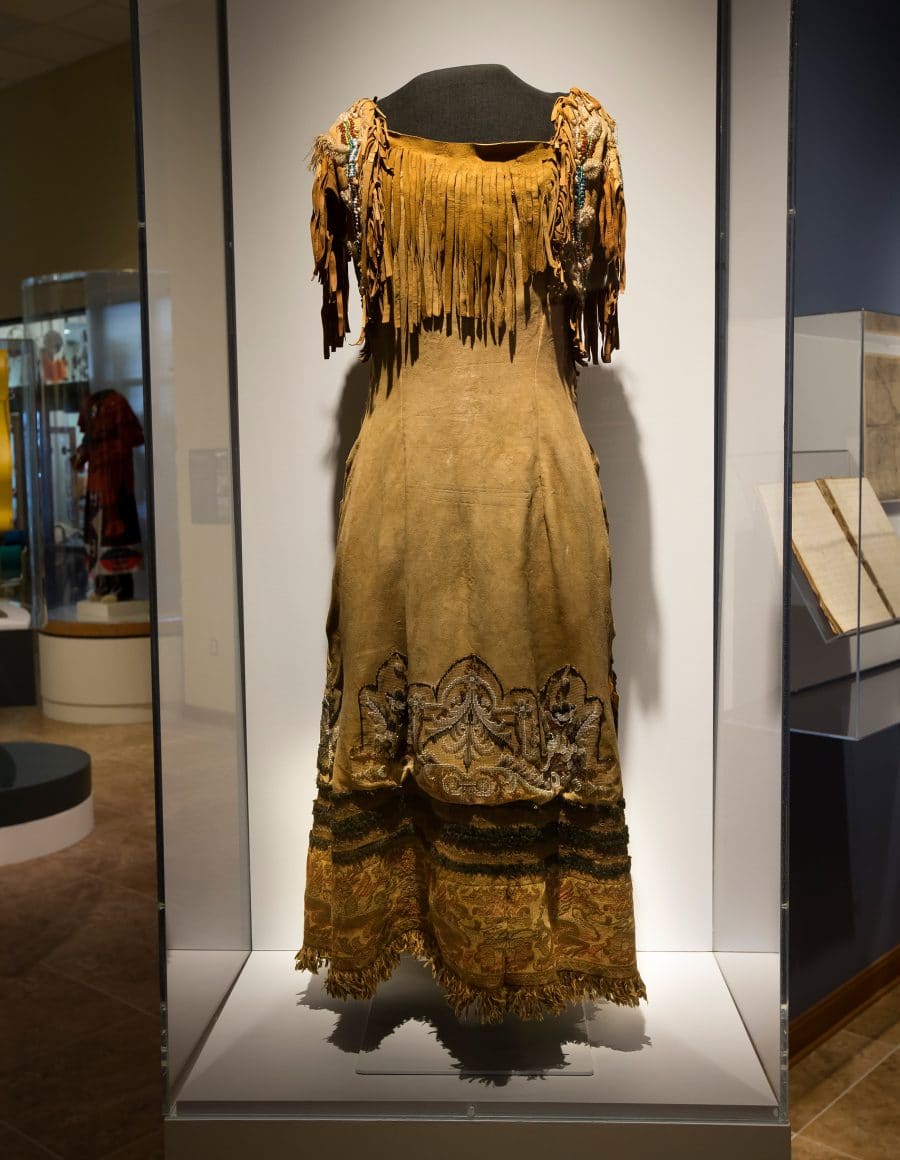After decades of turmoil in Kansas, Citizen Potawatomi leaders began planning for the Tribe to start anew. Although the Treaty of 1861 provided Tribal members U.S. citizenship and land allotments in Kansas, the federal government did not honor the treaty’s terms. As a result, many Citizen Potawatomi lost everything. The CPN Cultural Heritage Center’s gallery Indian Territory: A Place To Call Our Own recognizes Potawatomi efforts to overcome the harsh living conditions, violence and land conflicts that ensued once arriving in Indian Territory.
“Kansas was a lot of chaos, and there was a lot of change that was happening because of the various treaties,” said Citizen Potawatomi Nation Cultural Heritage Center Director Kelli Mosteller, Ph.D. “In this gallery, we wanted to indicate a tone shift with the yellow to the country blue accent color. It highlights that although things were still chaotic once we moved to Indian Territory, it was also going to become our forever home.”
Final removal
As recompense for the Creek and Seminole nations’ support for the Confederacy during the Civil War, lands designated to the two tribes opened for new settlement. This inspired a convoy of Potawatomi leaders to travel from present-day Kansas to present-day Pottawatomie County, Oklahoma, as scouts.
“These individuals were prominent businessmen, and they actually tried to make the journey soon after the treaty was signed, but the weather conditions didn’t allow it,” Mosteller said.
After touring the new reservation, and due to pressure from U.S. officials, the Potawatomi decided to make Indian Territory the Tribe’s new home.
Seven affluent Potawatomi families then settled on the new reservation: Anderson, Melot, Clardy, Pettifer, Bergeron, Bourbonnais
“It was not an easy journey. There weren’t well-established trails or very many places to stop and resupply, and they had to go over a number of rivers,” she said.
Those who moved to Indian Territory paid for it out of their own pockets. To afford the trek, Tribal members sold belongings and gathered supplies before heading south. Unlike prior removals, groups came as they could, not all at once. Seasonal weather conditions also influenced what time of year was most advantageous to make the trip.
“All of these things were taken into consideration, which is one of the reasons from 1872 to 1877, only a few hundred people came down,” Mosteller said.
Unexpected neighbors

The CHC features this cup — found during an excavation project on Potawatomi Land — within the Indian Territory gallery.
As soon as the first Potawatomi arrived in Indian Territory, they realized the Absentee Shawnee already called this area home.
While the Absentee Shawnee did not have rights to the land outlined in any treaty or formal document, they had resided in present-day Pottawatomie County for nearly 40 years. The tribe fled the area during the Civil War but returned once the war ended. Because the Absentee Shawnee settled before the Potawatomi, many lived on the reservation’s highest-quality property located near water sources.
“When we tried to settle near the Absentee Shawnee, we would try to assert our claim that this was our land, and it led to a lot of strife,” Mosteller said. “Stories from this time in the Nation’s history indicate people burned down each other’s houses and stole each other’s horses and cattle. It wasn’t
Catholicism’s “cradle in the west”
When the Citizen Potawatomi relocated, the church followed. The Tribe provided the Catholic Church
Father Isidore Robot officially established the Sacred Heart Mission as a worship center and boys school in the late 1870s. By 1880, educational opportunities extended to girls with the opening of Saint Mary’s Academy. Because of Sacred Heart’s impact, CHC staff designed an exhibit dedicated to preserving this piece of Tribal history.
Federal policies required the Citizen Potawatomi to provide the Absentee Shawnee plots of the Potawatomi reservation, and both tribal headquarters are still within a half-mile of each other.
“The first thing visitors see when walking into this gallery from the West of the Mississippi gallery is the stained glass from the Sacred Heart exhibit,” Mosteller said. This intentional design and placement of the piece
To create the glass, staff captured high-resolution images of the parish’s windows during a repair project several years ago.
“We were able to then work with FireLake Designs to replicate those images and create a backlight vinyl graphic that the Eaton-Quade company out of Oklahoma City then cut out to look like an actual pane of glass,” said Blake Norton, curator.
The Sacred Heart exhibit can conjure a variety of emotions depending upon each visitor’s personal experience, Mosteller said.
“This is our history, good or bad. We’re not going to leave it out just because it had very painful elements, and it does symbolize a lot of the cultural loss that we experienced,” Mosteller said. “When we decided to put the Sacred Heart exhibit here, we knew it would evoke some strong feelings, but we also knew we had to address it.”
For the Potawatomi living around Sacred Heart, it served as the center for commerce, worship
“Our ancestors had a true connection to this space,” Mosteller said. “The grounds at Sacred Heart were a very central part of the community.”
A photo
“It’s a really neat piece that shows some of what the curriculum was based on like geography and mathematics,” Norton said, then pointed to the image. “It also shows what the classroom looked like, which is pretty standard for that time, especially for mission schools.”
Sacred Heart also holds historical prominence with the Catholic Church. It became the first cathedral in Indian Territory and served as the territorial Catholic seat for several years before moving to Guthrie.
Father Dom Bede
Oral traditions suggest Citizen Potawatomi member Albert Negahnquet wanted to “educate the Potawatomi people in the teachings of the Bible in their own language,” Norton said.
Because of Albert’s clergy interest, his father enrolled him in Sacred Heart Mission. Albert eventually attended seminary in Rome and became the Catholic Church’s first ordained full-blooded Native American priest. His clerical name became Father Dom Bede.

“Albert was one of the older sons of Steven Negahnquet, who was a Tribal leader in Kansas,” Norton said. “The Negahnquets played a pivotal role in the mission being invited onto the reservation. They also put some blood and sweat equity into constructing the building at Sacred Heart.”
Early in his priesthood, Father Dom Bede toured parishes in Wisconsin. “While there, a family invited him over for dinner, and he gifted them this rosary,” Norton said, then pointed to the hand-knotted rosary featured in this gallery.
“Records state Albert quickly gained attention at Sacred Heart as a child prodigy, especially when it came to theology and religious studies,” Norton added.
Indian Advocate
In 1888, Benedictine Monks began publishing The Indian Advocate, which covered church business, Indian affairs, history
“Our records indicate that this is the second oldest printing press in the state of Oklahoma,” Norton said. “The oldest is the Cherokee Advocate in Tahlequah, Oklahoma, for the Cherokee Nation.”
The monks continued to use the press for pamphlets and fliers until a large earthquake damaged buildings at St. Gregory’s University in 2011.
“They were going to demolish the building the press was in, but they needed a place to move the press to, and it’s been with us since that time,” he added.
Assimilation through education
While many Potawatomi children attended Sacred Heart and St. Mary’s Academy, groups also attended other boarding schools like Carlisle Indian Industrial School in Pennsylvania, including Citizen Potawatomi member David Johnson.
“Assimilation policies were intended to make us lose our culture and language, to outlaw our religious practices, to break up family units, and in a lot of ways, it was successful because we didn’t have any other choice,” Mosteller said.
When David arrived at Carlisle, he received a chest. His son Richard “Dick” Johnson graciously donated the piece to the CHC.
Regardless of what American Indian boarding school a child attended, the goal remained the same.
“From our understanding, inside the chest was a uniform, pants, jacket, a pair of boots, hat and some dinnerware like a cup and plate,” Norton said. “What’s really neat about this piece is you still see some of the badging that would have been printed on the sides. It still has the tray insert in there for some of the smaller things and toiletries, but that was it. That’s what they had, and these chests were their locker that contained all of their possessions.”
“However, just because some went to class and were good students doesn’t mean that they ever necessarily felt less Potawatomi — we just don’t know that,” she added.
Allotment interactive
Federal policies did not stop at assimilation. When the Dawes Act of 1887 passed, it required a survey of all reservations across the country. After completing the assessment, tribal members received acres of the reservation based upon their household status. After all members received plots, the remaining acreage fell under the federal government’s domain. While allotment policies were new to many tribes, the Citizen Potawatomi went through the process before moving to Indian Territory.
“We had already been down this road. We knew what to expect. We probably didn’t fight it as much as some of the tribes experiencing it for the first time because basically, the infrastructure had already been laid for this,” Mosteller said. “Our reservation had already been surveyed and broken up into allotment plots on a grid.”
Within this gallery, an interactive map depicts the various Potawatomi land allotments within CPN tribal jurisdiction.
CHC staff and the CPN Information Technology Department collaborated to create the comprehensive map. Each red plot indicates 1872 allotments, and the purple illustrates those from 1887.
“Even though we’d been through the allotment process two times before, the actual number of allotments were much greater from the Dawes Act in 1887. One, we had more Tribal members down here, and two, there was a lot more support from the federal government into making this happen,” Mosteller added.
Land Run of 1891
Even though the Tribe purchased every acre included in the reservation, once each eligible Tribal member received their allotments, the government opened the remaining land for free to settlers through the Land Run of 1891.
More than 20,000 hopefuls gathered Sept. 22, 1891, to stake their claim on Citizen Potawatomi, Iowa and Sac and Fox land the federal government deemed as surplus.
“By the time the land runs happened, there were already quite a few non-Natives in the area,” Mosteller said. “The sooners didn’t just come in the day before the land run. A lot of the sooners had been in and out of Indian Territory scouting and squatting.”
Growth across Indian Territory quickly followed. By October 1891, the government determined counties and county seats, but the development extended beyond bureaucracy. Settlers quickly established buildings, communities, businesses, trade
Opportunities in Indian Territory abounded, and it became a haven for legendary fugitives.
Outlaws
“Lawlessness is something that we had to deal with
The only tribal law enforcement at this time were the Indian police, and they only had jurisdiction over Natives.
“If a non-Native person in Indian Territory has broken the law — killed someone, committed crimes — we had to wait for a marshal or someone from cities like St. Louis and Little Rock to come, which could take four days of travel,” she said. “And we didn’t have the jurisdiction to hold non-Natives. It was really just martial law at this point.”
Fugitives including the Belle Starr gang, Dalton Gang and others moved through the territory and Potawatomi reservation.
“It was a well-trodden path for outlaws to hang out here because if you went south, you moved into Chickasaw territory. If you went north, you entered Cherokee territory, and they had well-established governance,” Mosteller explained. “We were prime real estate for violence and chaos.”
Wedding dress

CHC staff feature Mary Anderson Bourbonnais’ wedding dress on display at the end of the gallery. Mary Anderson married Antoine Bourbonnais and joined the six other Potawatomi families who first settled in Indian Territory.
The CHC obtained the wedding dress, Mary’s eagle fan and some other artifacts from the Pottawatomie County Historical Society.
“The Historical Society felt that once we opened the Cultural Heritage Center, these pieces belonged here, which is a fantastic gesture,” Norton added.
The Bourbonnais took allotments near the current CPN headquarters, and the family’s original cabin sits outside of the CHC. Interior tours are not available because a recent structural report on the cabin revealed potential safety issues. However, visitors are welcome to enjoy this piece of Citizen Potawatomi history from the benches and walkways located nearby.
Sovereignty
From the 1870s through early Oklahoma statehood, Citizen Potawatomi never stopped asserting that Tribal members are both Potawatomi and U.S. citizens.
“When they saw injustice — when they saw they were being treated in a way that wasn’t right — they would send letters to the Indian Agent, to the Commissioner of Indian Affairs and to the president’s office,” Mosteller said.
The efforts made once the Citizen Potawatomi arrived in Indian Territory also helped bring about the Indian Reorganization Act. After the IRA’s passage in 1934, approximately 160 tribes, including the Citizen Potawatomi, adopted constitutions and began forming governments.
While the early 1900s ushered in dramatic changes for the Citizen Potawatomi, it also provided a foundation for tribal self-governance, which can be seen throughout the CPN government today.
Mosteller encourages visitors as they move out of the Indian Territory gallery to remember all the efforts made by the Potawatomi since European arrival to the early 20th century.
“In the colonial wars, we were fighting in the forests and hills of the Great Lakes. We are now fighting in courts, through documentation, through asserting our treaty rights and through asserting our rights as citizens of both the United States and of our Tribe,” Mosteller said.
Although federal policies through time caused the Citizen Potawatomi to lose its battle to live by the Tribe’s cultural standards, members began finding ways to win by exercising sovereignty. This instilled hope into the next generation of Citizen Potawatomi as well as formed the foundation needed to grow and prosper as a Great Lakes tribe in Oklahoma.
